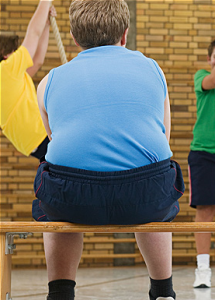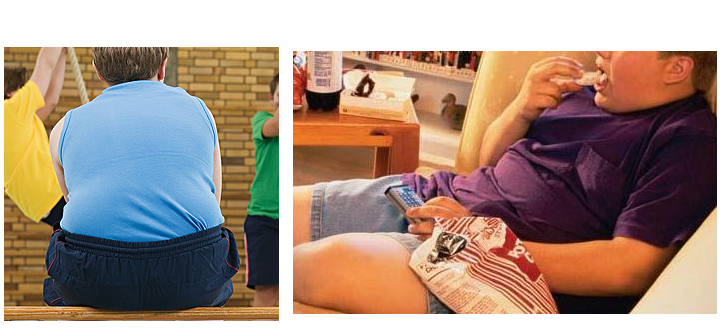April 1, 2011
Tracey L. Chavous
Health and Wellness Writer
Healthy Living
Thirty years ago, children led very different lives than young people today.  Children ingest more sugar and processed fast foods and are more sedentary than ever. With video games, computers, large screen TV monitors, less outdoor recess and physical education, older and younger children — as young as 3-5 years old – are increasingly less active. Most households have two working parents, which leads to less time available for students to play outside for longer periods and fewer opportunities for eating healthier home-cooked meals as a family.
Children ingest more sugar and processed fast foods and are more sedentary than ever. With video games, computers, large screen TV monitors, less outdoor recess and physical education, older and younger children — as young as 3-5 years old – are increasingly less active. Most households have two working parents, which leads to less time available for students to play outside for longer periods and fewer opportunities for eating healthier home-cooked meals as a family.
The National Center for Chronic Disease Prevention and Health Promotion states that childhood obesity has more than tripled in the past 30 years. The prevalence of obesity among children aged 6 to 11 years increased from 6.5% in 1980 to 19.6% in 2008. The prevalence of obesity among adolescents aged 12 to 19 years increased from 5.0% to 18.1%. That adds up to about 1 in 3 overweight children; if a child is black or Hispanic, the numbers increase to every 2 out of 3 children. These alarming statistics jolt our society into bracing for a future as the first generation to bury children due to adult-type diseases (Type 2 diabetes, high blood pressure, high cholesterol, heart problems and asthma) that robbed them of their childhoods. This growing epidemic is preventative in nature and can be diminished greatly with some consistent and realistic intentions of parents and adults working together.
Know Your Numbers; Adjust Your Portions
Children are eating super sized, high calorie, low nutrient food and drink  portions at home, at fast food restaurants and in school. The average plate size 2 decades ago has gone from 10 ½ inches to 12 ½ inches. Snack packaging has increased in size as well. An average muffin size is now called a “mini muffin”, and most muffins are now triple the size, adding up to a whopping 200-300 extra calories. Cup sizes for beverages in restaurants are well beyond 8 oz. and allow for unlimited refills, which can range from 150-350 additional calories. It’s important to consider serving size and the appropriate portion sizes for your growing child and then make a plan to stick with it. Registered dietician Michelle Mirizzi (www.nouirshinteactive.com) states that serving sizesaredefined by the USDA Food Guide Pyramid as a standard amount. It also helps us identify how much food to eat and how many calories and nutrients are in foods. A portion is the amount of food that you choose to eat. There is no standard portion size and no single right or wrong portion size. However, knowing the size of a serving can help your child determine healthy portions.
portions at home, at fast food restaurants and in school. The average plate size 2 decades ago has gone from 10 ½ inches to 12 ½ inches. Snack packaging has increased in size as well. An average muffin size is now called a “mini muffin”, and most muffins are now triple the size, adding up to a whopping 200-300 extra calories. Cup sizes for beverages in restaurants are well beyond 8 oz. and allow for unlimited refills, which can range from 150-350 additional calories. It’s important to consider serving size and the appropriate portion sizes for your growing child and then make a plan to stick with it. Registered dietician Michelle Mirizzi (www.nouirshinteactive.com) states that serving sizesaredefined by the USDA Food Guide Pyramid as a standard amount. It also helps us identify how much food to eat and how many calories and nutrients are in foods. A portion is the amount of food that you choose to eat. There is no standard portion size and no single right or wrong portion size. However, knowing the size of a serving can help your child determine healthy portions.
Here are some other common portions and their respective Food Guide Pyramid serving sizes. How do these compare with your child’s portions?
| Common portions that people eat | Food Guide Pyramid Serving Size | Total servings per Food Guide Pyramid |
| 1 bagel | ½ bagel | = 2 servings |
| 1 English Muffin | ½ English muffin | = 2 servings |
| 1 Hamburger bun | ½ bun | = 2 servings |
| 1 cup cooked rice | ½ cup cooked rice | = 2 servings |
| 1 cups cooked pasta | ½ cup cooked pasta | = 2 servings |
In each food group, examine the different Food Guide Pyramid examples indicating 1 serving each. How do these compare with your child’s portions?
- Grains
- 1 slice bread, waffle or pancake
- ½ bagel, hamburger bun, or English muffin
- ½ cup cooked rice, pasta or cereal
- 1 cup ready to eat cereal
- Vegetables
- ¾ cup (6 fluid ounces) 100% vegetable juice
- 1 cup raw, leafy vegetables or salad
- ½ cup cooked or canned vegetables
- Fruits
- 1 medium apple, orange or banana
- ½ cup fruit (canned, cooked or raw)
- ½ cup (4 fluid ounces) 100% fruit juice
- ¼ cup dried fruit (raisins, apricots or prunes)
- Milk
- 1 cup milk or yogurt
- 2 ounces processed cheese (American)
- 1 ½ ounces natural cheese (cheddar)
- Meat and Beans
- 1 tablespoons of peanut butter counts as 1 ounce
- ¼ cup nuts or 20-24 almonds
- 1 medium size egg
- 2-3 ounces of poultry, meat or fish (2-3 servings)
- ¼ cup of beans
Rest and Relax in a Healthier Way
As spring and summer break approaches, plan for daily activity even if you are a busy working parent. If children at home are older and not at  camp or daycare, plan activities that occur in the morning before you leave for work or in the evening. Be the model your children need for eating as well as for physical activity. Allow for at least 60 minutes of physical activity per day that incorporates aerobic activity such as walking, running, jump rope, biking, swimming, tennis and Frisbee along with muscle and bone strengthening exercises such as stretching, yoga and lightweight dumb bells between 5-8 pounds. There are several inexpensive and free ways to teach your children how to do certain exercises; the public library is full of books as well as videos on exercise activities. Sites such as YouTube.com can provide visual tutorials on exercise how-tos as well. If technology is your family’s preference, there are downloadable exercises as well as virtual games. Wii Sports and Xbox 360 Kinect encourage young people to get off the sofa and move, laugh and play physically.
camp or daycare, plan activities that occur in the morning before you leave for work or in the evening. Be the model your children need for eating as well as for physical activity. Allow for at least 60 minutes of physical activity per day that incorporates aerobic activity such as walking, running, jump rope, biking, swimming, tennis and Frisbee along with muscle and bone strengthening exercises such as stretching, yoga and lightweight dumb bells between 5-8 pounds. There are several inexpensive and free ways to teach your children how to do certain exercises; the public library is full of books as well as videos on exercise activities. Sites such as YouTube.com can provide visual tutorials on exercise how-tos as well. If technology is your family’s preference, there are downloadable exercises as well as virtual games. Wii Sports and Xbox 360 Kinect encourage young people to get off the sofa and move, laugh and play physically.
Ask Questions
Regular yearly checkups with your pediatrician can foster better communication about your child’s growth and development. On www.netplaces.com, it was shared that pediatricians use growth charts to determine growth at the child’s regular checkup. Height, weight and head circumference are measured and charted over time. There are a wide range of acceptable, healthy sizes for kids. Weight and height are determined by several factors, including genetics, lifestyle, nutrition, environment, activity, hormones, and overall health and well-being. Healthy, normal growth should continue along the same curve on the chart throughout childhood. Changes in this pattern or movement off the curve may signal health problems. If you feel your child is overweight or gaining weight rapidly, ask the pediatrician for help or resources that could be implemented for creating a plan that is realistic. This is beneficial over the long run so that lasting changes can be noticeable. The internet is a great source of basic information that can assist with answering questions or obtaining ideas on how to prepare meals for children and connect with other families experiencing similar problems with obesity.
Resources for Families, Schools and Communities
First Lady Michelle Obama’s “Let’s Move” Campaign
Let’s Move! is a comprehensive initiative, launched by the First Lady, dedicated to solving the problem of obesity within a generation. This program was created so that kids born today will grow up healthier and pursue their dreams. www.letsmove.gov
Nourish Interactive is a free one-stop resource for fun nutrition games for kids, interactive nutrition tools. These tips for parents and health educators are used to promote healthy living for the whole family and created by nutrition and health care professionals. http://www.nourishinteractive.com/
The Center for Disease Control’s site offers resources and tools along with updated research and information. http://www.cdc.gov/nccdphp/dnpao/index.html
Create customized fitness journals and other BAM (Body and Mind) activities at http://www.bam.gov/sub_physicalactivity/index.html
Blubberbusters offers online health and weight loss education and an online support community of several thousand overweight kids, teens and parents from around the world. The site provides self-managed personal weight loss charts and goal setting. www.blubberbuster.com
HealthyChildren.org is the only parenting website backed by 60,000 pediatricians committed to the attainment of optimal physical, mental and social health and well-being for all infants, children, adolescents and young adults. http://www.healthychildren.org/english/health-issues/conditions/obesity/Pages/default.aspx




